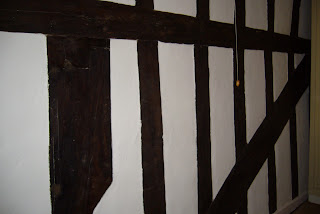Two treats this week. First, we tried out the National Theatre Live scheme at our local cinema. We drove a few miles, parked for free and settled into our seats in good time. Shots of the theatre audience similarly settling into their seats added realism. Then we enjoyed every minute of the play - "People" by Alan Bennett, starring Frances de la Tour - as if we were in the front Stalls at the National. We had imagined rather static shots, rather creaky transitions but this was not the case.
As for the play itself, it zipped along, fuelled by Bennett's sense of the absurd, and his biting satire on the heritage industry. It did turn into a rant at times, but what a change from the average film! And this opportunity was shared at hundreds of local cinemas up and down the country. No need to trek into London, no problems with trains - we were home within fifteen minutes.
Next, we did go up to London to see the Ice Age Art exhibition at the British Museum. We met my sister and her husband and treated ourselves to the Ice Age menu in the Court restaurant, a very civilised venue. Now what did they eat in the Ice Age? From the evidence of the exhibition, which was largely composed of bone fragments, the answer is anything that they could catch. Probably they did eat small quanties of raw meat and share out the fish between them. Perhaps potatoes were still somewhere in the future, likewise grain, and therefore bread. But did they really have red peppers and courgettes with their protein? Seems unlikely.
As for the exhibition, it lacked something. The items on display spanned nearly twenty thousand years - a mind-boggling length of time. Yet we had little sense of the lives of those who made these scratchings on bone - images of running horses, and of reindeer, and many tiny images of the female form. As archaeological finds these must have been thrilling, but they are underwhelming when presented in a glass case. More resonant were the modern minimalist stone sculptures presented alongside them.
So now, this is the same chart but with two stitches per square. The stepped pattern of the original becomes clearer here, but the white still shouts too much. In the original, the gold base had been stamped in a diaper pattern which showed through the garnets as a chequer-board. This could be achieved by patterning the red diamond in K2P2. But still no gold.
For a while I knitted Newfoundland mittens non-stop. Perhaps the mesh used in these could be done in a metallic yarn to contain the coloured shapes? The white needs to be toned down to an old white, in the Farrow and Ball sense. Would the resulting fabric work as the back of a glove, rather than mittens? We'll see.
As for the play itself, it zipped along, fuelled by Bennett's sense of the absurd, and his biting satire on the heritage industry. It did turn into a rant at times, but what a change from the average film! And this opportunity was shared at hundreds of local cinemas up and down the country. No need to trek into London, no problems with trains - we were home within fifteen minutes.
Next, we did go up to London to see the Ice Age Art exhibition at the British Museum. We met my sister and her husband and treated ourselves to the Ice Age menu in the Court restaurant, a very civilised venue. Now what did they eat in the Ice Age? From the evidence of the exhibition, which was largely composed of bone fragments, the answer is anything that they could catch. Probably they did eat small quanties of raw meat and share out the fish between them. Perhaps potatoes were still somewhere in the future, likewise grain, and therefore bread. But did they really have red peppers and courgettes with their protein? Seems unlikely.
As for the exhibition, it lacked something. The items on display spanned nearly twenty thousand years - a mind-boggling length of time. Yet we had little sense of the lives of those who made these scratchings on bone - images of running horses, and of reindeer, and many tiny images of the female form. As archaeological finds these must have been thrilling, but they are underwhelming when presented in a glass case. More resonant were the modern minimalist stone sculptures presented alongside them.
Remember the garnet-inlaid shoulder clasp from Sutton Hoo? Millefiori glass in blue and white and garnet inlays in a geometric pattern. This is the pattern charted: one stitch representing one square.
Intarsia, rather than Fairisle patterning. No gold of course.
So now, this is the same chart but with two stitches per square. The stepped pattern of the original becomes clearer here, but the white still shouts too much. In the original, the gold base had been stamped in a diaper pattern which showed through the garnets as a chequer-board. This could be achieved by patterning the red diamond in K2P2. But still no gold.
For a while I knitted Newfoundland mittens non-stop. Perhaps the mesh used in these could be done in a metallic yarn to contain the coloured shapes? The white needs to be toned down to an old white, in the Farrow and Ball sense. Would the resulting fabric work as the back of a glove, rather than mittens? We'll see.














.JPG)